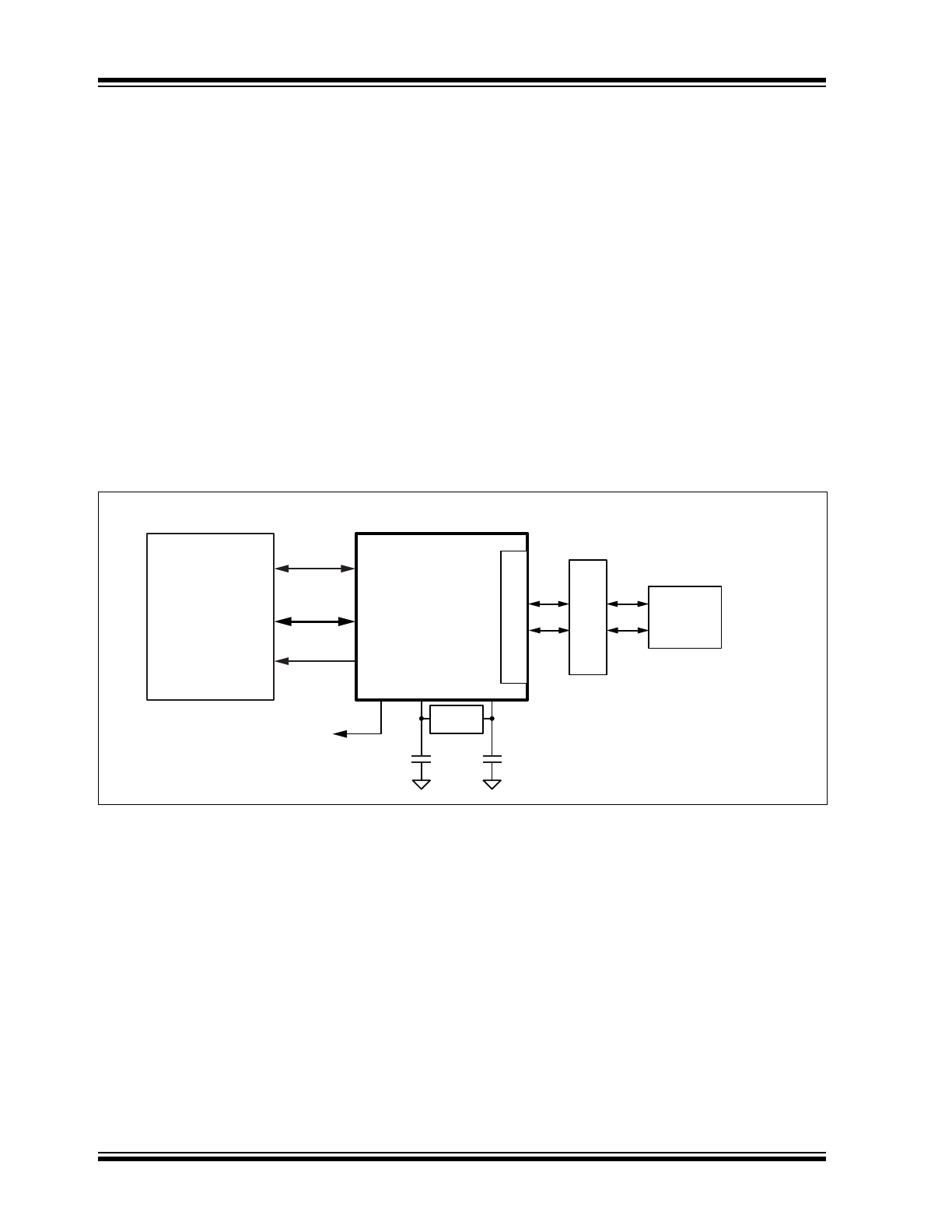
2016 Microchip Technology Inc.
DS00002275A-page 1
Features
• Single-Chip 10BASE-T/100BASE-TX IEEE 802.3
Compliant Ethernet Transceiver
• MII Interface Support (KSZ8091MNX)
• RMII v1.2 interface support with a 50 MHz refer-
ence clock output to MAC, and an option to input
a 50 MHz reference clock (KSZ8091RNB)
• Back-to-Back Mode Support for a 100 Mbps Cop-
per Repeater
• MDC/MDIO Management Interface for PHY Reg-
ister Configuration
• Programmable Interrupt Output
• LED Outputs for Link and Activity Status Indica-
tion, plus speed indication for KSZ8091RNB
• On-Chip Termination Resistors for the Differential
Pairs
• Baseline Wander Correction
• HP Auto MDI/MDI-X to Reliably Detect and Cor-
rect Straight-Through and Crossover Cable Con-
nections with Disable and Enable Option
• Auto-Negotiation to Automatically Select the
Highest Link-Up Speed (10/100 Mbps) and
Duplex (Half/Full)
• Energy Efficient Ethernet (EEE) Support with
Low-Power Idle (LPI) Mode and Clock Stoppage
(MII Version Only) for 100BASE-TX and Transmit
Amplitude Reduction with 10BASE-Te Option
• Wake-on-LAN (WOL) Support with Either Magic
Packet, Link Status Change, or Robust Custom-
Packet Detection
• HBM ESD Rating (6 kV)
• Power-Down and Power-Saving Modes
• LinkMD
®
TDR-Based Cable Diagnostics to Iden-
tify Faulty Copper Cabling
• Parametric NAND Tree Support for Fault Detec-
tion Between Chip I/Os and the Board
• Loopback Modes for Diagnostics
• Single 3.3V Power Supply with V
DD
I/O Options
for 1.8V, 2.5V, or 3.3V
• Built-In 1.2V Regulator for Core
• Available in 32-pin 5 mm x 5 mm QFN Package
Target Applications
• Game Consoles
• IP Phones
• IP Set-Top Boxes
• IP TVs
• LOM
• Printers
KSZ8091MNX/RNB
10BASE-T/100BASE-TX
Physical Layer Transceiver

KSZ8091MNX/RNB
DS00002275A-page 2
2016 Microchip Technology Inc.
TO OUR VALUED CUSTOMERS
It is our intention to provide our valued customers with the best documentation possible to ensure successful use of your Microchip
products. To this end, we will continue to improve our publications to better suit your needs. Our publications will be refined and
enhanced as new volumes and updates are introduced.
If you have any questions or comments regarding this publication, please contact the Marketing Communications Department via
E-mail at
docerrors@microchip.com
. We welcome your feedback.
Most Current Data Sheet
To obtain the most up-to-date version of this data sheet, please register at our Worldwide Web site at:
http://www.microchip.com
You can determine the version of a data sheet by examining its literature number found on the bottom outside corner of any page.
The last character of the literature number is the version number, (e.g., DS30000000A is version A of document DS30000000).
Errata
An errata sheet, describing minor operational differences from the data sheet and recommended workarounds, may exist for cur-
rent devices. As device/documentation issues become known to us, we will publish an errata sheet. The errata will specify the
revision of silicon and revision of document to which it applies.
To determine if an errata sheet exists for a particular device, please check with one of the following:
• Microchip’s Worldwide Web site;
http://www.microchip.com
• Your local Microchip sales office (see last page)
When contacting a sales office, please specify which device, revision of silicon and data sheet (include -literature number) you are
using.
Customer Notification System
Register on our web site at
www.microchip.com
to receive the most current information on all of our products.

2016 Microchip Technology Inc.
DS00002275A-page 3
KSZ8091MNX/RNB
Table of Contents
1.0 Introduction ..................................................................................................................................................................................... 4
2.0 Pin Description and Configuration .................................................................................................................................................. 5
3.0 Functional Description .................................................................................................................................................................. 15
4.0 Register Descriptions .................................................................................................................................................................... 40
5.0 Operational Characteristics ........................................................................................................................................................... 57
6.0 Electrical Characteristics ............................................................................................................................................................... 58
7.0 Timing Diagrams ........................................................................................................................................................................... 60
8.0 Reset Circuit ................................................................................................................................................................................. 69
9.0 Reference Circuits — LED Strap-In Pins ...................................................................................................................................... 70
10.0 Reference Clock - Connection and Selection ............................................................................................................................. 71
11.0 Magnetic - Connection and Selection ......................................................................................................................................... 72
12.0 Package Outline .......................................................................................................................................................................... 74
Appendix A: Data Sheet Revision History ........................................................................................................................................... 75
The Microchip Web Site ...................................................................................................................................................................... 76
Customer Change Notification Service ............................................................................................................................................... 76
Customer Support ............................................................................................................................................................................... 76
Product Identification System ............................................................................................................................................................. 77

KSZ8091MNX/RNB
DS00002275A-page 4
2016 Microchip Technology Inc.
1.0
INTRODUCTION
1.1
General Description
The KSZ8091 is a single-supply 10BASE-T/100BASE-TX Ethernet physical-layer transceiver for transmission and
reception of data over standard CAT-5 unshielded twisted pair (UTP) cable.
The KSZ8091 is a highly integrated PHY solution. It reduces board cost and simplifies board layout by using on-chip
termination resistors for the differential pairs, by integrating a low-noise regulator to supply the 1.2V core, and by offering
a flexible 1.8/2.5/3.3V digital I/O interface.
The KSZ8091MNX offers the Media Independent Interface (MII) and the KSZ8091RNB offers the Reduced Media Inde-
pendent Interface (RMII) for direct connection with MII/RMII-compliant Ethernet MAC processors and switches.
Energy Efficient Ethernet (EEE) provides further power saving during idle traffic periods and Wake-on-LAN (WOL) pro-
vides a mechanism for the KSZ8091 to wake up a system that is in standby power mode.
The KSZ8091 provides diagnostic features to facilitate system bring-up and debugging in production testing and in prod-
uct deployment. Parametric NAND tree support enables fault detection between KSZ8091 I/Os and the board. LinkMD
®
TDR-based cable diagnostics identify faulty copper cabling.
The KSZ8091MNX and KSZ8091RNB are available in 32-pin, lead-free QFN packages.
FIGURE 1-1:
SYSTEM BLOCK DIAGRAM
KSZ8091MNX/
KSZ8091RNB
MAGNETICS
RJ-45
CONNECTOR
MEDIA TYPES:
10BASE-T
100BASE-TX
ON-CHIP TERMINATION
RESISTORS
MII/RMII
MDC/ MDIO
MANAGEMENT
XO
XI
25MHz
XTAL
22pF
22pF
10/100Mbps
MII/RMII MAC
50MHz
(KSZ8091RNB)
REF_CLK
PME_N
(SYSTEM
POWER
CIRCUIT)

2016 Microchip Technology Inc.
DS00002275A-page 5
KSZ8091MNX/RNB
2.0
PIN DESCRIPTION AND CONFIGURATION
FIGURE 2-1:
32-PIN 5 MM X 5 MM QFN ASSIGNMENT, KSZ8091MNX (TOP VIEW)
TABLE 2-1:
SIGNALS - KSZ8091MNX
Pin
Number
Pin
Name
Type
Note
2-1
Description
1
GND
GND
Ground.
2
VDD_1.2
P
1.2V core V
DD
(power supplied by KSZ8091MNX)
Decouple with 2.2 µF and 0.1 µF capacitors to ground.
3
VDDA_3.3
P
3.3V analog V
DD
4
RXM
I/O
Physical receive or transmit signal (– differential)
5
RXP
I/O
Physical receive or transmit signal (+ differential)
GND
VDD_1.2
VDDA_3.3
RXM
RXP
TXM
TXP
XO
RXD3/PHY
AD0
MDC
MDIO
REXT
XI
RXD2/PHY
AD1
RXD1/PHY
AD2
RXD0/DUPLEX
1
2
3
4
5
6
7
8
9
10
11 12 13 14
15
16
24
23
22
21
20
19
18
17
32 31 30 29 28 27
26
25
TXD0
TXEN
TXC/PME_EN
INTRP/PME_N2/NAND_TREE#
RXER/ISO
RXC/B-CAST_OFF
RXDV/CONFIG2
VDDIO
COL/CONFIG0
CRS/CONFIG1
LED0/PME_N1/NW
A
YEN
TXER
RST#
TXD3
TXD2
TXD1
PADDLE
GROUND
(ON BOTTOM OF CHIP)

KSZ8091MNX/RNB
DS00002275A-page 6
2016 Microchip Technology Inc.
6
TXM
I/O
Physical transmit or receive signal (– differential)
7
TXP
I/O
Physical transmit or receive signal (+ differential)
8
XO
O
Crystal feedback for 25 MHz crystal
This pin is a no connect if an oscillator or external clock source is used.
9
XI
I
Crystal/Oscillator/External Clock input
25 MHz ±50 ppm
10
REXT
I
Set PHY transmit output current
Connect a 6.49 kΩ resistor to ground on this pin.
11
MDIO
Ipu/
Opu
Management Interface (MII) Data I/O
This pin has a weak pull-up, is open-drain, and requires an external 1.0 kΩ
pull-up resistor.
12
MDC
Ipu
Management Interface (MII) Clock input
This clock pin is synchronous to the MDIO data pin.
13
RXD3/
PHYAD0
Ipu/O
MII mode: MII Receive Data Output[3] (
Note 2-2
)
Config mode: The pull-up/pull-down value is latched as PHYADDR[0] at the
de assertion of reset.
See the
Strap-In Options - KSZ8091MNX
section for details.
14
RXD2/
PHYAD1
Ipd/O
MII mode: MII Receive Data Output[2] (
Note 2-2
)
Config mode: The pull-up/pull-down value is latched as PHYADDR[1] at the
deassertion of reset.
See the
Strap-In Options - KSZ8091MNX
section for details.
15
RXD1/
PHYAD2
Ipd/O
MII mode: MII Receive Data Output[1] (
Note 2-2
)
Config mode: The pull-up/pull-down value is latched as PHYADDR[2] at the
de assertion of reset.
See the
Strap-In Options - KSZ8091MNX
section for details.
16
RXD0/
DUPLEX
Ipu/O
MII mode: MII Receive Data Output[0] (
Note 2-2
)
Config mode: The pull-up/pull-down value is latched as DUPLEX at the de-
assertion of reset.
See the
Strap-In Options - KSZ8091MNX
section for details.
17
VDDIO
P
3.3V, 2.5V, or 1.8V digital V
DD
18
RXDV/
CONFIG2
Ipd/O
MII mode: MII Receive Data Valid output
Config mode: The pull-up/pull-down value is latched as CONFIG2 at the de-
assertion of reset.
See the
Strap-In Options - KSZ8091MNX
section for details.
19
RXC/
B-CAST_OFF
Ipd/O
MII mode: MII Receive Clock output
Config mode: The pull-up/pull-down value is latched as B-CAST_OFF at the
de assertion of reset.
See the
Strap-In Options - KSZ8091MNX
section for details.
20
RXER/ISO
Ipd/O
MII mode: MII Receive Error output
Config mode: The pull-up/pull-down value is latched as ISOLATE at the de-
assertion of reset.
See the
Strap-In Options - KSZ8091MNX
section for details.
TABLE 2-1:
SIGNALS - KSZ8091MNX (CONTINUED)
Pin
Number
Pin
Name
Type
Note
2-1
Description

2016 Microchip Technology Inc.
DS00002275A-page 7
KSZ8091MNX/RNB
21
INTRP/
PME_N2/
NAND_Tree#
Ipu/
Opu
Interrupt output: Programmable interrupt output, with Register 1Bh as the
Interrupt Control/Status register, for programming the interrupt conditions and
reading the interrupt status. Register 1Fh, bit [9] sets the interrupt output to
active low (default) or active high.
PME_N output: Programmable PME_N output (pin option 2). When asserted
low, this pin signals that a WOL event has occurred.
Config mode: The pull-up/pull-down value is latched as NAND Tree# at the
deassertion of reset.
See the
Strap-In Options - KSZ8091MNX
section for details.
This pin has a weak pull-up and is an open-drain.
For Interrupt (when active low) and PME functions, this pin requires an exter-
nal 1.0 kΩ pull-up resistor to V
DDIO
(digital V
DD
).
22
TXC/
PME_EN
Ipd/O
MII mode: MII Transmit Clock output
MII back-to-back mode: No connection
Config mode: The pull-up/pull-down value is latched as PME_EN at the de-
assertion of reset.
See the
Strap-In Options - KSZ8091MNX
section for details.
23
TXEN
I
MII mode: MII Transmit Enable input
24
TXD0
I
MII mode: MII Transmit Data Input[0] (
Note 2-3
)
25
TXD1
I
MII mode: MII Transmit Data Input[1] (
Note 2-3
)
26
TXD2
I
MII mode: MII Transmit Data Input[2] (
Note 2-3
)
27
TXD3
I
MII Mode: MII Transmit Data Input[3] (
Note 2-3
)
28
COL/
CONFIG0
Ipd/O
MII mode: MII Collision Detect output
Config mode: The pull-up/pull-down value is latched as CONFIG0 at the de-
assertion of reset.
See the
Strap-In Options - KSZ8091MNX
section for details.
29
CRS/
CONFIG1
Ipd/O
MII mode: MII Carrier Sense output
Config mode: The pull-up/pull-down value is latched as CONFIG1 at the de-
assertion of reset.
See the
Strap-In Options - KSZ8091MNX
section for details.
TABLE 2-1:
SIGNALS - KSZ8091MNX (CONTINUED)
Pin
Number
Pin
Name
Type
Note
2-1
Description

KSZ8091MNX/RNB
DS00002275A-page 8
2016 Microchip Technology Inc.
Note 2-1
P = power supply
GND = ground
I = input
O = output
I/O = bi-directional
Ipu = Input with internal pull-up (see
Electrical Characteristics
for value).
Ipd = Input with internal pull-down (see
Electrical Characteristics
for value).
Ipu/O = Input with internal pull-up (see
Electrical Characteristics
for value) during power-up/reset;
output pin otherwise.
Ipd/O = Input with internal pull-down (see
Electrical Characteristics
for value) during power-up/reset;
output pin otherwise.
Ipu/Opu = Input with internal pull-up (see
Electrical Characteristics
for value) and output with internal
pull-up (see
Electrical Characteristics
for value).
Note 2-2
MII RX Mode: The RXD[3:0] bits are synchronous with RXC. When RXDV is asserted, RXD[3:0]
presents valid data to the MAC.
30
LED0/
PME_N1/
NWAYEN
Ipu/O
LED output: Programmable LED0 output
PME_N Output: Programmable PME_N Output (pin option 1)
In this mode, this pin has a weak pull-up, is an open-drain, and requires an
external 1.0 kΩ pull-up resistor to V
DDIO
(digital V
DD
).
Config mode: Latched as auto-negotiation enable (Register 0h, bit [12]) at the
de-assertion of reset.
See the
Strap-In Options - KSZ8091MNX
section for details.
The LED0 pin is programmable using Register 1Fh bits [5:4], and is defined
as follows.
LED Mode = [00]
Link/Activity
Pin State
LED Definition
No Link
High
OFF
Link
Low
ON
Activity
Toggle
Blinking
LED Mode = [01]
Link
Pin State
LED Definition
No Link
High
OFF
Link
Low
ON
LED Mode = [10], [11]: Reserved
31
TXER
Ipd
MII mode: MII Transmit Error input
For EEE mode, this pin is driven by the EEEMAC to pull up this pin for
KSZ8091MNX transmit into the LPI state.
For non-EEE mode, this pin is not defined for error transmission from MAC to
KSZ8091MNX and can be left as a no connect.
For NAND Tree testing, this pin should be pulled high by a pull-up resistor.
32
RST#
Ipu
Chip reset (active low)
PADDLE
GND
GND
Ground
TABLE 2-1:
SIGNALS - KSZ8091MNX (CONTINUED)
Pin
Number
Pin
Name
Type
Note
2-1
Description

2016 Microchip Technology Inc.
DS00002275A-page 9
KSZ8091MNX/RNB
Note 2-3
MII TX Mode: The TXD[3:0] bits are synchronous with TXC. When TXEN is asserted, TXD[3:0]
presents valid data from the MAC.
The strap-in pins are latched at the de-assertion of reset. In some systems, the MAC MII receive input pins may drive
high/low during power-up or reset, and consequently cause the PHY strap-in pins on the MII signals to be latched to
unintended high/low states. In this case, external pull-ups (4.7 kΩ) or pull-downs (1.0 kΩ) should be added on these
PHY strap-in pins to ensure that the intended values are strapped-in correctly.
Note 2-4
Ipu/O = Input with internal pull-up during power-up/reset; output pin otherwise.
Ipd/O = Input with internal pull-down during power-up/reset; output pin otherwise.
Ipu/Opu = Input with internal pull-up and output with internal pull-up.
TABLE 2-2:
STRAP-IN OPTIONS - KSZ8091MNX
Pin Number
Pin Name
Type
Note 2-4
Description
15
PHYAD2
Ipd/O
PHYAD[2:0] is latched at de-assertion of reset and is configurable to
any value from 0 to 7 with PHY Address 1 as the default value.
PHY Address 0 is assigned by default as the broadcast PHY
address, but it can be assigned as a unique PHY address after pull-
ing the B-CAST_OFF strapping pin high or writing a ‘1’ to Register
16h, bit [9].
PHY Address bits [4:3] are set to 00 by default.
14
PHYAD1
Ipd/O
13
PHYAD0
Ipu/O
18
CONFIG2
Ipd/O
The CONFIG[2:0] strap-in pins are latched at the de-assertion of
reset.
29
CONFIG1
CONFIG[2:0] Mode
000
MII (default)
28
CONFIG0
110
MII back-to-back
001 – 101,
111
Reserved, not used
22
PME_EN
Ipd/O
PME output for Wake-on-LAN
Pull-up = Enable
Pull-down (default) = Disable
At the de-assertion of reset, this pin value is latched into Register
16h, bit [15].
20
ISO
Ipd/O
Isolate mode
Pull-up = Enable
Pull-down (default) = Disable
At the de-assertion of reset, this pin value is latched into Register 0h,
bit [10].
16
DUPLEX
Ipu/O
Duplex Mode:
Pull-up (default) = Half-duplex
Pull-down = Full-duplex
At the de-assertion of reset, this pin value is latched into Register 0h,
Bit [8].
30
NWAYEN
Ipu/O
Nway Auto-Negotiation Enable:
Pull-up (default) = Enable auto-negotiation
Pull-down = Disable auto-negotiation
At the de-assertion of reset, this pin value is latched into Register 0h,
Bit [12].
19
B-CAST_OFF
Ipd/O
Broadcast Off – for PHY Address 0:
Pull-up = PHY Address 0 is set as an unique PHY address
Pull-down (default) = PHY Address 0 is set as a broadcast PHY
address
At the de-assertion of reset, this pin value is latched by the chip.
21
NAND_Tree#
Ipu/Opu
NAND Tree Mode:
Pull-up (default) = Disable
Pull-down = Enable
At the de-assertion of reset, this pin value is latched by the chip.

KSZ8091MNX/RNB
DS00002275A-page 10
2016 Microchip Technology Inc.
FIGURE 2-2:
32-PIN 5 MM X 5 MM QFN ASSIGNMENT, KSZ8091RNB (TOP VIEW)
TABLE 2-3:
SIGNALS - KSZ8091RNB
Pin
Number
Pin Name
Type
Note 2-1
Description
1
GND
GND
Ground.
2
VDD_1.2
P
1.2V core V
DD
(power supplied by KSZ8091RNB)
Decouple with 2.2 µF and 0.1 µF capacitors to ground.
3
VDDA_3.3
P
3.3V analog V
DD
4
RXM
I/O
Physical receive or transmit signal (– differential)
5
RXP
I/O
Physical receive or transmit signal (+ differential)
6
TXM
I/O
Physical transmit or receive signal (– differential)
7
TXP
I/O
Physical transmit or receive signal (+ differential)
8
XO
O
Crystal feedback for 25 MHz crystal
This pin is a no connect if an oscillator or external clock source is used.
GND
VDD_1.2
VDDA_3.3
RXM
RXP
TXM
TXP
XO
PHY
AD0
MDC
MDIO
REXT
XI
PHY
AD1
RXD1/PHY
AD2
RXD0/DUPLEX
1
2
3
4
5
6
7
8
9
10
11 12 13 14
15
16
24
23
22
21
20
19
18
17
32 31 30 29 28 27
26
25
TXD0
TXEN
PME_EN
INTRP/PME_N2/NAND_TREE#
RXER/ISO
REF_CLK/B-CAST_OFF
CRS_DV/CONFIG2
VDDIO
CONFIG0
CONFIG1
LED0/PME_N1/NW
A
YEN
LED1/SPEED
RST#
NC
NC
TXD1
PADDLE
GROUND
(ON BOTTOM OF CHIP)
